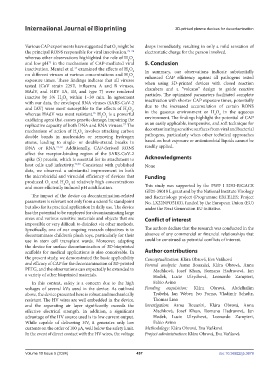Page 465 - IJB-10-5
P. 465
International Journal of Bioprinting 3D-printed plasma devices for decontamination
Various CAP experiments have suggested that O might be drops immediately, resulting in only a mild sensation of
3
the principal RONS responsible for viral inactivation. 72–74 electrostatic charge for the person involved.
whereas other observations highlighted the role of H O
2
2
and low pH in the mechanism of CAP-mediated viral 5. Conclusion
75
inactivation. Mentel et al. examined the effects of H O In summary, our observations indicate substantially
76
2
2
on different viruses at various concentrations and H O enhanced CAP efficiency against all pathogens tested
2
2
exposure times. These findings indicate that all viruses when using 3D-printed devices with closed reaction
tested (CoV strain 229E, influenza A and B viruses, chambers and a “volcano” design to guide reactive
HAdV, and HRV 1A, 1B, and type 7) were rendered particles. The optimized parameters facilitated complete
inactive by 3% H O within 1–30 min. In agreement
2
2
with our data, the enveloped RNA viruses (SARS-CoV-2 inactivation with shorter CAP exposure times, potentially
and IAV) were most susceptible to the effects of H O , due to the increased accumulation of certain RONS
2
2
whereas HAdV was most resistant. H O is a powerful in the gaseous environment or H O in the aqueous
76
2
2
2
2
oxidizing agent that causes genetic damage, impairing the environment. The findings highlight the potential of CAP
replicative capacity of both DNA and RNA viruses. The as an easily applicable, inexpensive, and soft technique for
77
mechanism of action of H O involves attacking carbon decontaminating sensitive surfaces from viral and bacterial
2
2
double bonds in nucleosides or removing hydrogen pathogens, particularly when other technical approaches
atoms, leading to single- or double-strand breaks in based on heat exposure or antimicrobial liquids cannot be
DNA or RNA. 77,78 Additionally, CAP-derived RONS readily applied.
affect the receptor-binding region of the SARS-CoV-2
spike (S) protein, which is essential for its attachment to Acknowledgments
host cells and infectivity. 79,80 Consistent with published None
data, we observed a substantial improvement in both
the microbicidal and virucidal efficiency of devices that Funding
produced O and H O at relatively high concentrations
2
2
3
and more efficiently induced pH acidification. This study was supported by the FWF I 5293-B/GACR
GF21-39019 L grant and by the National Institute Virology
The impact of the device on decontamination-related and Bacteriology project (Programme EXCELES; Project
parameters is relevant not only from a scientific standpoint No. LX22NPO5103), funded by the European Union (EU)
but also for its practical application in daily use. The device under the Next Generation EU initiative.
has the potential to be employed for decontaminating large
areas and various sensitive materials and objects that are Conflict of interest
impossible or very difficult to disinfect via other methods.
Specifically, one of our ongoing research objectives is to The authors declare that the research was conducted in the
decontaminate children’s plush toys, particularly for their absence of any commercial or financial relationships that
use in stem cell transplant wards. Moreover, adapting could be construed as potential conflicts of interest.
the device for surface decontamination of 3D-bioprinted
scaffolds for medical applications is also conceivable. In Author contributions
the present study, we demonstrated the basic applicability Conceptualization: Klára Obrová, Eva Vaňková
and efficacy of CAP for the decontamination of 3D-printed Formal analysis: Asma Bouazizi, Klára Obrová, Anna
PETG, and the observations can expectedly be extended to Machková, Josef Khun, Romana Hadravová, Jan
a variety of other bioprinted materials. Hodek, Lucie Ulrychová, Leonardo Zampieri,
In this context, safety is a concern due to the high Fabio Avino
voltages of several kVs used in the device. As outlined Funding acquisition: Klára Obrová, Abdelhalim
above, the device presented here is robust and mechanically Trabelsi, Jan Weber, Ivo Furno, Vladimír Scholtz,
resistant. The HV wires are well embedded in the device, Thomas Lion
and the separating air layer significantly exceeds the Investigation: Asma Bouazizi, Klára Obrová, Anna
effective electrical strength. In addition, a significant Machková, Josef Khun, Romana Hadravová, Jan
advantage of the HV source used is its low current output. Hodek, Lucie Ulrychová, Leonardo Zampieri,
While capable of delivering HV, it generates only low Fabio Avino
currents on the order of 100 µA, well below the safety limit. Methodology: Klára Obrová, Eva Vaňková
In the event of direct contact with the HV wires, the voltage Project administration: Klára Obrová, Eva Vaňková
Volume 10 Issue 5 (2024) 457 doi: 10.36922/ijb.3679

